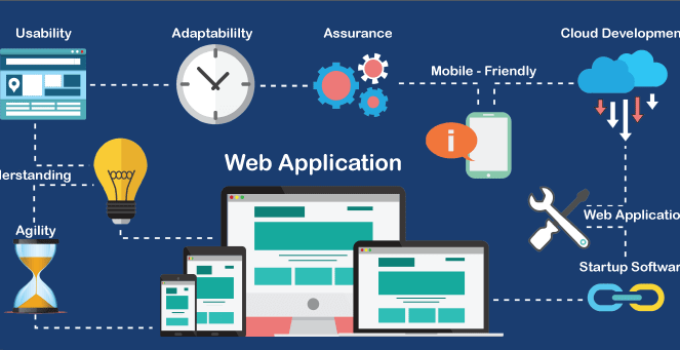Even 15-20 years ago, it was impossible to assume that Web & Mobile Application Development would become an integral part of life. Today, this type of online tool is used for various tasks, including business process optimization, selling goods and services, disseminating information, and communicating with users.
Web application as a business development tool

source:winklix
Unlike standard applications, we are talking about programs that can work fully even without installation on the device. A telephone, tablet or computer gets online access to data, and the user does not need to install it in permanent memory – this is the main distinguishing feature of web applications.
This kind of Web & Mobile Application Development tools should not be confused with websites. Web applications are interactive, users can perform various actions in them: order a product or service, book a ticket, leave a comment or review, edit content, and so on. Examples of web applications can include full-fledged online editors, such as “Documents” from Google.
Creating a web application is today definitely one of the most progressive ways of investing time and resources in the development of a company, because its implementation allows you to:
- automate business processes for both employees and staff;
- attract the attention of the target audience and stand out from the competition;
- make the solution of popular tasks easier, more reliable and safer.
An eloquent example is the e-commerce platform Shopify, which was created in 2004 by a group of enthusiasts who wanted to sell sports equipment. At the time, it was hard to imagine that Shopify would become one of the biggest online platforms that would power e-commerce. As often happens in such cases, the pioneering team was able to solve their own problems – and subsequently created the basis for achieving the goals that other entrepreneurs often set for themselves.
How do web applications work now?

Source:webpuppies.com.sg
The functionality of web applications means that they can work with several types of pages, including:
- statistical – the server part creates a page in response to a request and sends it to the browser, regardless of the user’s actions, so that different users will see the same material for the same request;
- dynamic – the server part generates a page in response to a request, only the material first passes through the application server and is formed depending on which commands were sent.
Regardless of whether there is a web application for e-commerce, communication, content creation or other purposes, this kind of application works on a client-server basis. That is why the following components are distinguished in the structure:
- client part – responsible for the actions performed by the user;
- server part – responsible for the processes occurring on the server;
- database – a structure for orderly storage of information and access to it.
Depending on what tasks the creators of the project set themselves, they use certain tools for developing web applications. The main task is to provide functional interaction between the client and server parts, access to the database, the correct ability to generate and send ready-made pages in response to a request.
Based on the objectives, developers can create a web application that can be accessed from any device, or a demanding development environment that only devices with a certain level of hardware capabilities can work with. Various methods of developing web applications can be used, including open access to the architecture, as in Wikipedia, or with no such access to outsiders, as in any commercial or news application.
Types of all web applications
Based on what characterizes the project, it can be classified according to several main features.
According to the site building template
Here are web applications of several categories:
- multi-page (MPA) – the request is sent to the server, and the page is completely updated as a result of the response, replaced with a new one;
- single-page (SPA) – after sending a request to the server, part of the page that the application consists of is updated without a full reload;
- progressive (PWA) – retain their functionality even when they work offline due to disconnected access to the Internet.
Depending on which development environment is used, you can get a site template with the specified parameters.
According to destination

Source:dotcom-monitor.com
Modern web applications can perform many different functions. For example, these can be corporate portals, CRM (customer relationship management), ERP (enterprise resource planning), CMS (content management system), electronic commercial systems, and so on.
According to the used component models
There are several varieties in this category:
- Absolutely no component models. It is not uncommon for simple scripting development languages to help create a program that is conventionally referred to as CGI style, although it is a full-fledged application.
- With generic component models that are not intended for web applications alone. For example, with the help of COM / ActiveX objects on the Windows platform, it was possible to extend the functionality of a web server, to implement one or another business logic.
- With specialized component models. Examples are servlets and documents, universal components in the world of Java development. These components are managed by a special element – the web container.
Depending on which component model is used, web application optimization is also carried out according to completely different principles. Approaches can vary significantly based on functionality and end goals.
Professional web application development

Source:motocms.com
In the case of each such project, a certain cycle of actions is performed, in which the following stages can be distinguished:
- Collection of requirements and development of technical specifications. The customer voices both the main tasks and more global goals, and also supplements this with his own requirements so that it is possible to familiarize the developers with the task.
- Prototyping. The contractor creates a prototype of the future project, which reflects the future blocks and shows how they will interact in the web environment. It is important to choose a reliable and experienced contractor. Also at this stage, the necessary development technologies are determined.
- Design creation. Developers create a layout of the appearance to coordinate it with the customer following the functional prototype.
Maintaining a web project is much easier than a client application, especially when the tasks are completed and the documentation is provided!





